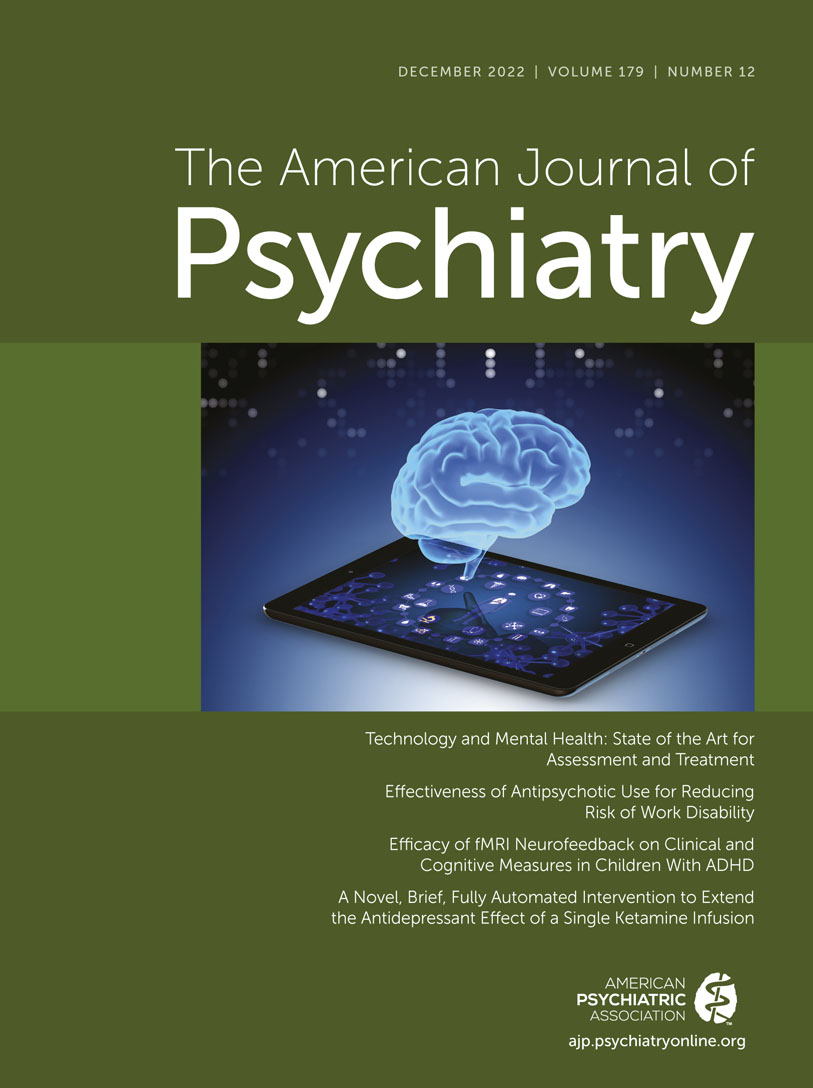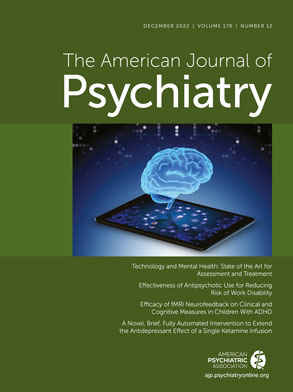The article by Lam and colleagues in this issue of the
Journal (
1) describes a well-conceived and well-conducted randomized sham-controlled trial that assessed the potential efficacy of functional MRI (fMRI) neurofeedback (fMRI-NF) as a treatment for children with attention deficit hyperactivity disorder (ADHD). Neurofeedback is a form of neuromodulation that transforms some measurement of brain function, in this instance fMRI-assessed blood-oxygen-level-dependent responses, into auditory or visual cues presented back in real time, allowing participants to learn, through trial and error, control of underlying neural activity. In this study, participants were asked to control the speed and direction of an on-screen rocketeer flying from ground level into space. The speed of the rocketeer reflected the level of brain activity in the right inferior frontal cortex (rIFC), with increases or decreases in brain activation leading to upward or downward movement. Investigators randomized 88 boys with ADHD diagnoses to active or sham fMRI-NF, administered multiple runs over four 1-hour sessions, and subsequently compared groups on a variety of ADHD-related outcomes.
The authors are to be commended on their study design, which reflects several features indicative of the best in current psychiatric research. The treatment targeted a clearly elucidated ADHD-associated mechanism of brain dysfunction, namely, patterns of underactivation in regions of the rIFC—areas implicated in attention and cognitive control (
2). The study built on a previous proof-of-concept fMRI-NF trial that suggested that rIFC-targeted neurofeedback led to improvement in ADHD symptoms compared with an active control condition (
3). Sample size was properly powered to detect medium-sized treatment effects, and the investigators employed procedures to confirm the fidelity of study group blinding. Efficacy was assessed with a single primary outcome measure, the well-validated ADHD Rating Scale (ADHD-RS), along with several hypothesis-generating secondary behavioral and cognitive endpoints.
The study failed to demonstrate differences between active and sham neurofeedback, even with its carefully elucidated brain target and commendable research design. The findings are consistent with other recent equally well designed investigations, further indicating that supposed benefits seen with neurofeedback are not due to any specific treatment effect or targeted change in brain activation, but rather are attributable to nonspecific factors, such as supportive coaching, positive reinforcement for sitting still, and other placebo effects (
4–
6). This mounting evidence raises questions as to how much additional research on ADHD neurofeedback is warranted. More critically, how much longer should clinicians continue to offer ADHD neurofeedback in the absence of any conclusive support of its effectiveness?
Neurofeedback has been available to treat ADHD for almost 40 years but has never received U.S. Food and Drug Administration approval as an efficacious therapy. Early claims of ADHD treatment success were largely based on case reports and small open trials. In an initial report in 1976, Lubar and Shouse (
7) administered sensorimotor rhythm neurofeedback to a single male child with “hyperactivity” and reported broadly defined improvements in classroom behaviors and laboratory measures of motor inhibition. Subsequently, sensorimotor rhythm neurofeedback was largely replaced with the theta/beta ratio protocol, in which participants were rewarded for successfully lowering theta and increasing beta spectral power as measured by EEG (
8). This approach assumed that ADHD was associated with a specific EEG pattern defined by an abnormally high ratio of theta to beta activity (
6). However, this rationale was undermined by the recognition that there was significant heterogeneity in EEG profiles among youths with ADHD diagnoses, that a high-theta–low-beta EEG profile is neither sensitive nor specific as an ADHD biomarker, and that no specific ADHD-associated EEG pattern exists (
9). More recently, alternative brain imaging approaches able to measure deeper levels of brain activity not accessible with surface EEG, including fMRI-NF, have been investigated (
6). The objective remains to modify patterns of underlying brain activation, presumed but never demonstrated to result in subsequent improvements in ADHD-related behaviors and cognition.
The literature on ADHD neurofeedback is decidedly mixed. Many studies relied on retrospective report, case series, and small samples. The interpretation of findings is further muddied by diagnostic uncertainties, ill-defined and multiple comorbidities, a lack of standardized protocols, and absent or inadequately blinded comparison groups (
10). An often-cited meta-analysis of nonpharmacological ADHD treatments revealed a high degree of positive expectation bias when primary efficacy raters were highly invested in treatment success, with perceived treatment differences becoming nonsignificant when limited to less proximal and more likely properly blinded raters (
11). A subsequent meta-analysis of ADHD neurofeedback similarly failed to find statistically significant benefits compared with sham or control conditions when analyses were limited to “probably blinded” raters (
12). Two additional meta-analyses have also failed to demonstrate ADHD-related improvements (
13,
14). In contrast, several other reports do assert that neurofeedback is well evidenced, with demonstrated medium to large treatment effect sizes (
15,
16). However, in evaluating these studies, one should be aware of methodological concerns as well as the possibility of financial conflicts of interest.
Publication of these well-done negative neurofeedback trials is an important contribution to the literature and is essential for advances in the field. Lam and colleagues forthrightly described their study’s limitations. Of greatest concern might be their decision to allow more than 60% of participants to remain on ADHD medications. Although medications were not taken on neurofeedback training days, ratings of ADHD behaviors presumably reflected the previous week’s overall symptoms and impairments. As noted by the authors, medication-related improvements might well have masked neurofeedback treatment effects. A second, but unacknowledged, concern was the authors’ decision to use the parent-rated ADHD-RS as their primary efficacy measure. While the ADHD-RS has well-documented treatment sensitivity, it is more typically utilized as a clinician-administered measure with clearly defined anchor points. Its sensitivity as a parent-rated outcome is less well described. Choosing an outcome with greater established validity as a parent-rated measure might have yielded different results. Other well-designed negative neurofeedback trials similarly report various limitations as well as some positive findings with post hoc secondary analyses (
4,
5). But given the totality of evidence, it is unclear whether further studies should be conducted to address these issues. Investigators must decide, given limitations in time and research funding, whether continued attempts to construct an evidence base supporting ADHD neurofeedback are warranted.
The most crucial consideration is whether, given the paucity of good evidence supporting its use, it remains appropriate for clinicians to recommend and families to engage in neurofeedback as a putative ADHD treatment. There is an argument, if one ignores the time required and the financial expense, that neurofeedback entails minimal risk. However, ADHD is a developmental disorder associated with significant long-term consequences. Standard approaches to ADHD management, in particular pharmacotherapy, are not without shortcomings but have an abundance of data supporting their acute benefits and long-term safety. Reliance on an unsubstantiated therapy in lieu of timely implementation of effective treatments cannot be in the best interests of children during periods of critical developmental change. Ongoing innovation in more effective and acceptable approaches to ADHD management is certainly essential and warranted. But neurofeedback as an ADHD treatment appears to have had its day.

